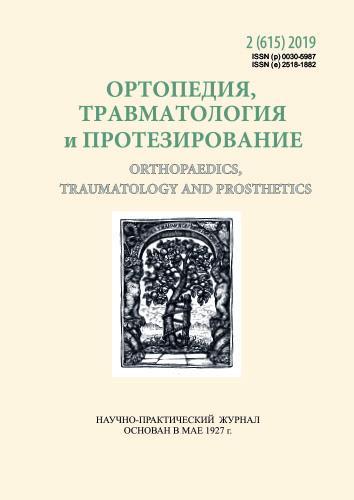Histological changes of the plantar plate in patients with metatarsalgia
DOI:
https://doi.org/10.15674/0030-59872019213-17Keywords:
plantar plate, metatarsalgia, foot, fibrous-cartilage enthesis, histologyAbstract
The plantar plate of the lesser toes is wide, strong and flexible fibro-cartilaginous structure of a rectangular or trapezoidal shape, passing from the plantar surface of the metatarsal neck to the base of the proximal phalanx. It is believed that degenerative changes of the plantar plate that occur during longterm cyclic overloads are the main cause of pain and the development of metatarsalgia.
Objective: analysis of the plantar plate histology results in patients with metatarsalgia.
Methods: 16 lesser metatarsophalangeal joint plantar plates of the 9 patients (2 were males, 7 were females with average age of (65.28 ± 10.32) years) with metatarsalgia were obtained for histology assessment (the second metatarsophalangeal joint plantar plates were 12, the third — 4). 8 plantar plate after lesser toe exarticulation, 8 — after resection arthroplasty were obtained. Fragments of plantar plate with proximal phalanx were selected for histology. Paraffin sections were analyzed with bright-field light microscopy (Olympus CX-41). Grades of severity of morphology were evaluated by VAS.
Results: the material in plantar plate biopsies was represented by fragments of pathologically altered connective tissue, changes in the regularity and density of collagen fibers, the appearance of blood vessels, a combination of loose connective tissue and dense connective tissue; subtotal and total fibronecrosis with complete degeneration of the fibrous-cartilage structure of the enthesis.
Conclusions: histological changes of the plantar plate in patients with metatarsalgia are characterized by an irreversible dystrophicdegenerative process in the fibrous-cartilage structure of the enthesis, which morphologically corresponds to non-specific enthesopathy.
References
- Cooper, M. T., & Coughlin, M. J. (2011). Sequential dissection for exposure of the second metatarsophalangeal joint. Foot & Ankle International, 32 (3), 294–299. doi:10.3113/fai.2011.0294
- Jastifer J. R., & Coughlin M. J. (2014). Metatarsophalangeal joint instability of the lesser toes: review and surgical technique. SA Orthopaedic Journal, 13 (2), 35–41.
- Apostolakos, J., Durant, T. J., Dwyer, C. R., Russell, R. P., Weinreb, J. H., Alaee, F., Beitzel, K., McCarthy, M. B., Cote, M. P., & Mazzocca, A. D. (2014). The enthesis: a review of the tendon-to-bone insertion. Muscle, Ligaments and Tendons Journal, 4 (3), 333–342.
- Nery, C., Umans, H., & Baumfeld, D. (2016). Etiology, clinical assessment, and surgical repair of plantar plate tears. Seminars in Musculoskeletal Radiology, 20 (02), 205–213. doi: 10.1055/s-0036-1581114
- Maas, N. M., Van der Grinten, M., Bramer, W. M., & Kleinrensink, G. (2016). Metatarsophalangeal joint stability: a systematic review on the plantar plate of the lesser toes. Journal of Foot and Ankle Research, 9 (1). doi: 10.1186/s13047-016-0165-2
- Weil, L., Sung, W., Weil, L. S., & Malinoski, K. (2011). Anatomic plantar plate repair using the weil metatarsal osteotomy approach. Foot & Ankle Specialist, 4 (3), 145–150. doi: 10.1177/1938640010397342
- Doty, J. F., & Coughlin, M. J. (2014). Metatarsophalangeal Joint Instability of the Lesser Toes and Plantar Plate Deficiency. Journal of the American Academy of Orthopaedic Surgeons, 22 (4), 235–245. doi: 10.5435/jaaos-22-04-235
- Umans, H., Srinivasan, R., Elsinger, E., & Wilde, G. E. (2014). MRI of lesser metatarsophalangeal joint plantar plate tears and associated adjacent interspace lesions. Skeletal Radiology, 43 (10), 1361–1368. doi:1 0.1007/s00256-014-1920-8
- Ringwood, M., Pham, P., Kreplick, A., & Maier, M. (2016). Plantar plate pathology: a review article. MOJ Orthopedics & Rheumatology, 6 (6). doi: 10.15406/mojor.2016.06.00241
- Finney, F., Scott, J., Jepsen, K., Holmes, J., & Talusan, P. (2018). Microvasculature of the plantar plate using nano-computed tomography. Foot & Ankle Orthopaedics, 3 (2), 2473011418S0000. doi: 10.1177/2473011418s00006
- Besse, J. L. (2017). Metatarsalgia. Orthopaedics & Traumatology: Surgery & Research, 103 (1S), S29-S39. doi: 10.1016/j.otsr.2016.06.020
- Gregg, J. M., Silberstein, M., Schneider, T., Kerr, J. B., & Marks, P. (2006). Sonography of Plantar Plates in Cadavers: Correlation with MRI and Histology. American Journal of Roentgenology, 186 (4), 948–955. doi:10.2214/ajr.04.1481
- Cook, J. L., & Purdam, C. R. (2008). Is tendon pathology a continuum? A pathology model to explain the clinical presentation of load-induced tendinopathy. British Journal of Sports Medicine, 43 (6), 409–416. doi:10.1136/bjsm.2008.051193
- Thomopoulos, S., Genin, G. M., & Galatz, L. M. (2010). The development and morphogenesis of the tendon-to-bone insertion — what development can teach us about healing. The Journal of Musculoskeletal and Neuronal Interactions, 10 (1), 35–45.
Downloads
How to Cite
Issue
Section
License
Copyright (c) 2019 Olena Turchin, Anastasiya Grigorovskaya, Andriy Lyabakh, Oleksandr Kostrub

This work is licensed under a Creative Commons Attribution 4.0 International License.
The authors retain the right of authorship of their manuscript and pass the journal the right of the first publication of this article, which automatically become available from the date of publication under the terms of Creative Commons Attribution License, which allows others to freely distribute the published manuscript with mandatory linking to authors of the original research and the first publication of this one in this journal.
Authors have the right to enter into a separate supplemental agreement on the additional non-exclusive distribution of manuscript in the form in which it was published by the journal (i.e. to put work in electronic storage of an institution or publish as a part of the book) while maintaining the reference to the first publication of the manuscript in this journal.
The editorial policy of the journal allows authors and encourages manuscript accommodation online (i.e. in storage of an institution or on the personal websites) as before submission of the manuscript to the editorial office, and during its editorial processing because it contributes to productive scientific discussion and positively affects the efficiency and dynamics of the published manuscript citation (see The Effect of Open Access).














